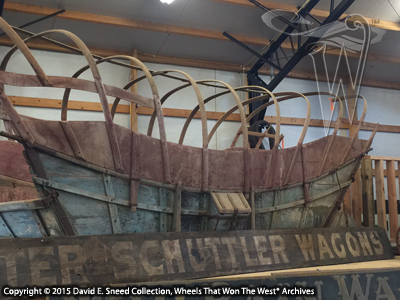With a history spanning more than 150years, the Nissen wagon brand (Winston-Salem, North Carolina) was built by one of the longest-surviving wooden wagoncompanies in America. The firm made wagons with bothstraight and curved beds. Those curved or arched configurations have caused some to misidentify the vehicle as a Conestoga. The unique designsare more accurately referred to as “Crooked bed wagons,” “tobacco wagons,” or “southernschooners.” Even though many of theNissen wagons share similar traits with a Conestoga, they are much smaller and lighterthan those legendary heavy freighters so often used on America’s NationalRoad.
 |
| Behind the original Peter Schuttler and Bain wooden signs shown here is a rare, eleven bow Nissen wagon box. Dating to the 1890’s, its size makes it among the largest examples of Nissen survivors. |
Not long ago, I came across someadditional history of the Nissen Wagon Works and thought I’d pass some of thatalong here. Published in 1913, these primarysource details give us even greater insight into a firm with origins almost asold as the American Revolution...
Throughout the Carolinas and Virginia, as well as inother parts of the country, the “Nissen” wagon has carried the name and fame ofWinston-Salem as a manufacturing center, and probably no other product of theTwin City is better and more favorably known, certainly none has been known forso long a time.
The first “Nissen” wagon was made in Salem more thanone hundred and twenty-five years ago by Tyco Nissen, a native of Denmark andone of the original colony of Moravians that settled that part of theState. His descendants have nearly allbeen wagon builders (it seems to run in the family), and the immense plant thathas grown through the years is now owned by William M. Nissen, proprietor ofthe George E. Nissen Co.
From the time of the building of the first wagon in1787 is a far cry, and the growth of the industry, backed always byintelligence, industry and fair dealing, has shown more plainly than anywritten word could do, how people appreciate a really good article.
It was not until 1834, when J.P. Nissen who died in1874, took hold of the business, that its real growth began, and he is lookedupon as the real founder of the enterprise.
The plant now covers about 15 acres, on which havebeen erected nearly half a hundred buildings and sheds, used for variouspurposes, but about 50 acres of the surrounding property is owned by theconcern, for this is a growing industry, and preparations for future expansionhave been made. The capacity of the plant is 8,000 wagons a year, andapproximately 200 people are employed, not including the men engaged in sellingthis standard wagon.
It is only natural that in more than a century theconstruction would draw near to perfection. Each generation of the family has contributed a share in one way oranother, and every feature that in any way would better the wagon is adopted... Some idea of its vast increase in the outputmay be gained by remembering the fact that on December 31, 1912, just onehundred and twenty-five years after the first Nissen wagon was built, a trainconsisting of eleven solid carload lots, consisting of 314 complete wagons,representing a cash value of $15,000, pulled out of Winston-Salem. If the wagons in this one shipment were stoodend to end, it would have made a solid string almost one and one-quarter milesin length.
These wagons had been produced, one every eighteenminutes of a working day, at the Nissen works. Some further idea of the growth of the enterprise may be gathered whenit is mentioned that in the pioneer days a complete wagon a day, working fromsun up to sun down, was considered a great achievement, and the talk of thesurrounding country.
Upon the retirement from active business of WilliamE. Nissen, some three years ago, William M. Nissen became proprietor andgeneral manager, and under his able and energetic leadership the enterprisecontinues to flourish and prosper, the product always being kept up to the highstandard that has made the “Nissen” wagon so long famous. Mr. Nissen was born in the neighborhood andhas all his life been identified with the business-life of Winston-Salem.
Today, the rich history and long legacyof Nissen wagons continue to reinforce the brand’s popularity with collectorsand enthusiasts. It’s an age-old storyretold every time an old home place is rediscovered, a barn door opened, and someonespots an all-but-forgotten part of America’s past. Covered in hay, clutter, and generations ofdust, these increasingly rare finds still have a way of capturing one’simagination and appreciation for a well-crafted set of wheels – just the way itwas more than a century ago.
By the way, if you haven’t signed up to receive this weekly blog via e-mail, just type your address in the "Follow By E-mail" section above. You'll receive a confirmation e-mail that you'll need to verify before you're officially on board. Once that's done, you'll receive an email every time we update the blog. Please don't hesitate to let us know if we can be of assistance. We appreciate your continued feedback and look forward to sharing even more wooden vehicle info in the coming weeks.
By the way, if you haven’t signed up to receive this weekly blog via e-mail, just type your address in the "Follow By E-mail" section above. You'll receive a confirmation e-mail that you'll need to verify before you're officially on board. Once that's done, you'll receive an email every time we update the blog. Please don't hesitate to let us know if we can be of assistance. We appreciate your continued feedback and look forward to sharing even more wooden vehicle info in the coming weeks.
Please Note: As with each of our blog writings, all imagery and text is copyrighted with All Rights Reserved. The material may not be broadcast, published, rewritten, or redistributed without prior written permission from David E. Sneed, Wheels That Won The West® Archives.